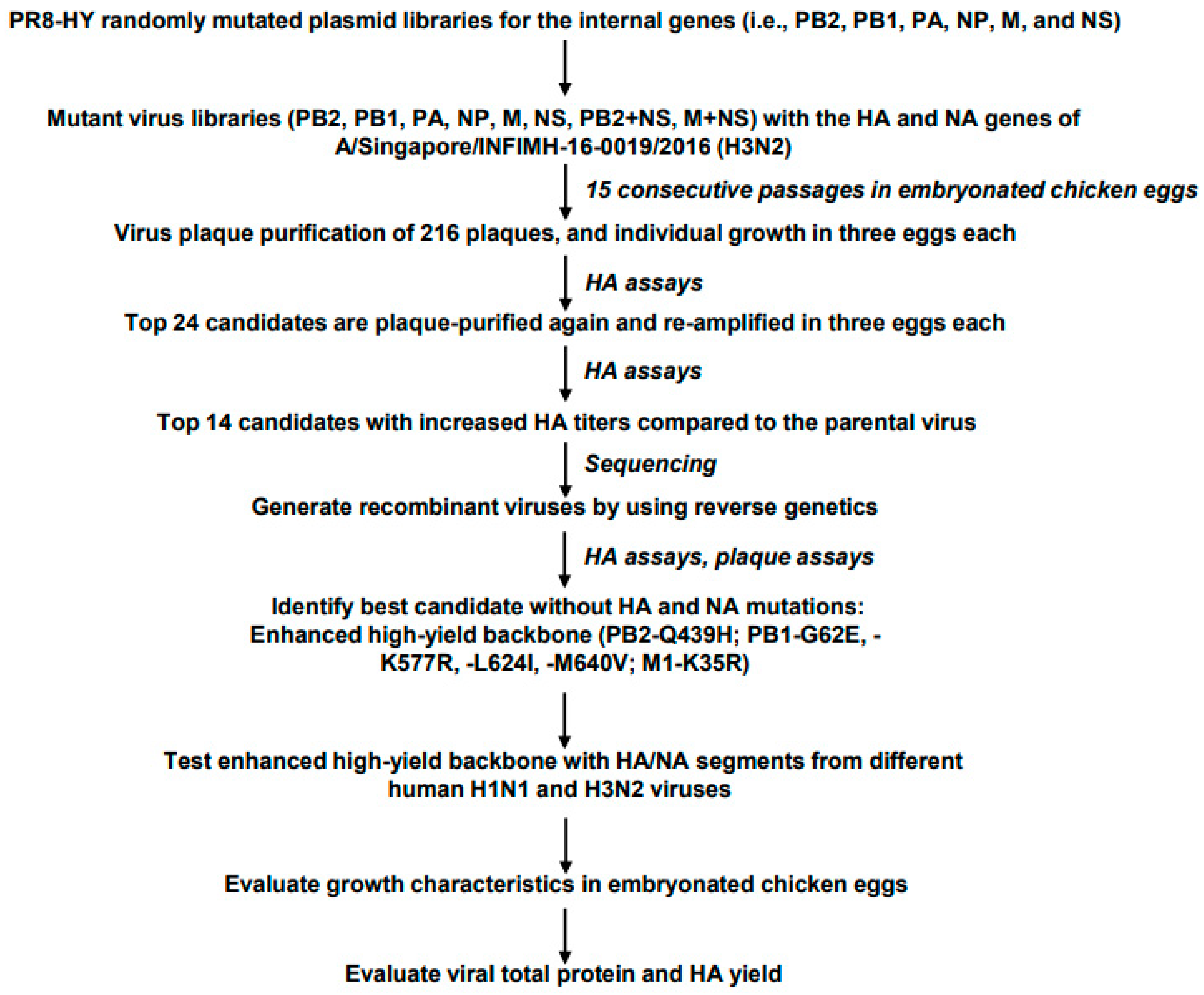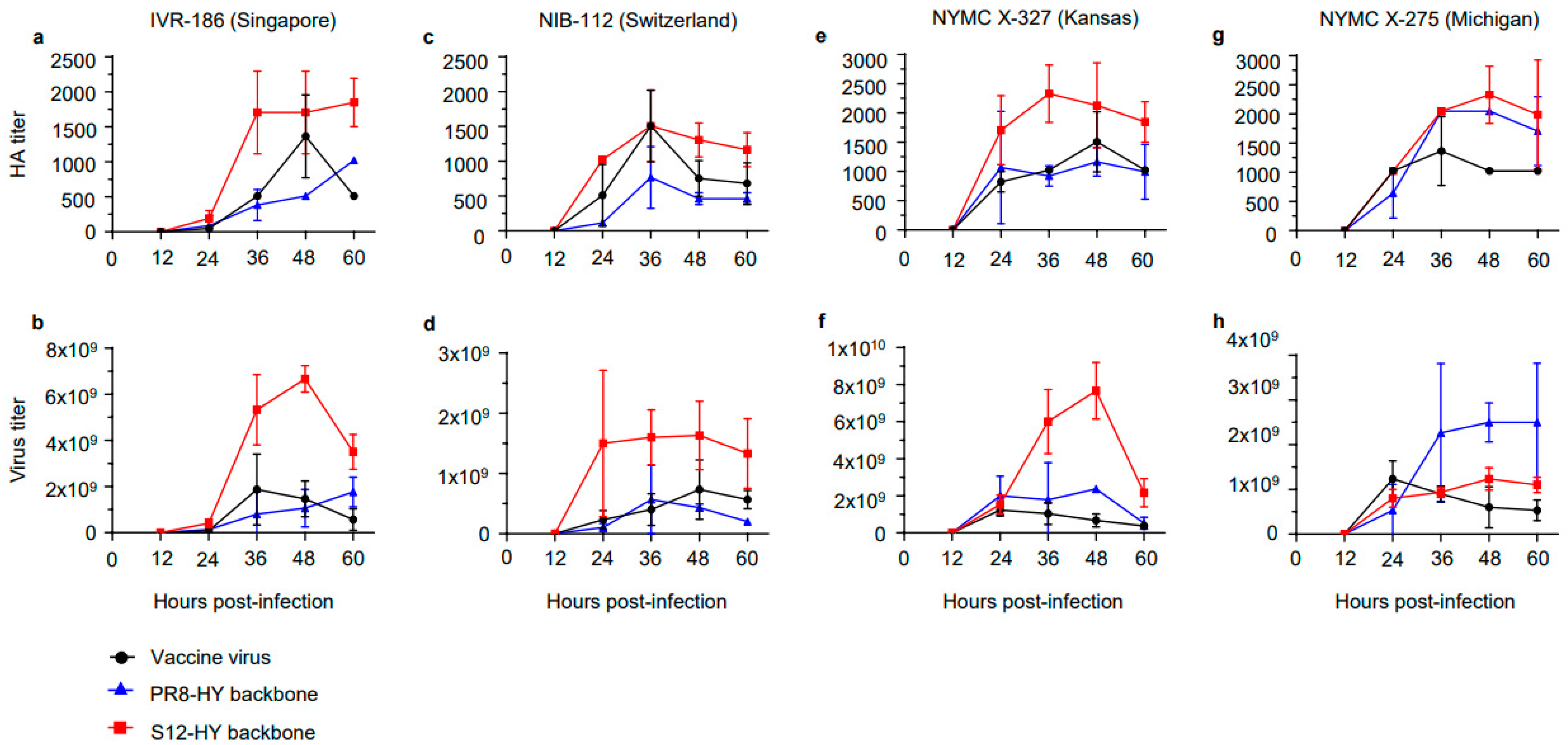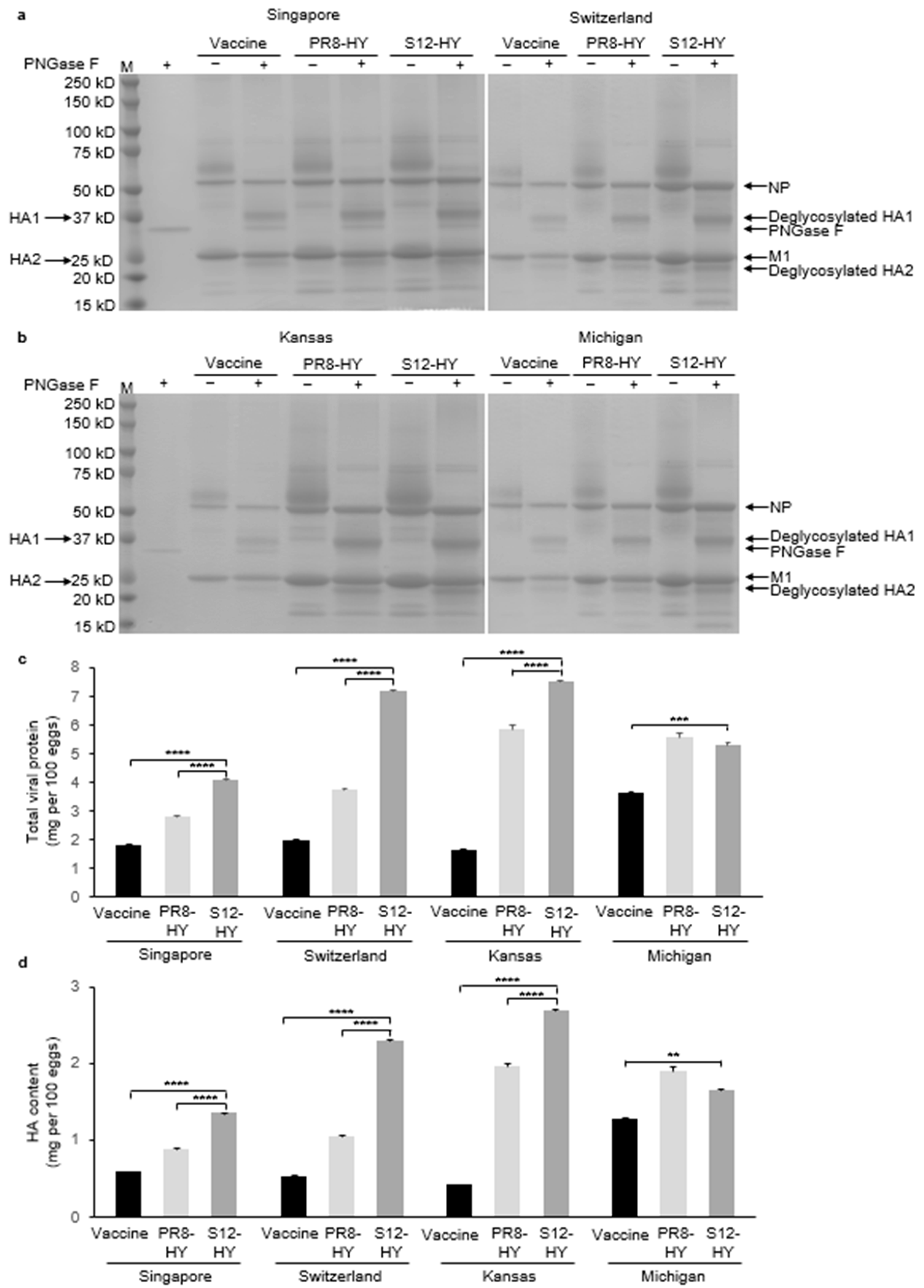Development of an Enhanced High-Yield Influenza Vaccine Backbone in Embryonated Chicken Eggs
Abstract
1. Introduction
2. Materials and Methods
2.1. Viruses and Cells
2.2. Construction of Plasmids, Plasmid Libraries, and Virus Libraries
2.3. Virus Amplification, Growth Kinetics, and Purification
2.4. Statistical Analysis
3. Results
3.1. Isolation of Enhanced High-Yield Vaccine Virus Backbones in Embryonated Chicken Eggs
3.2. Identification of Mutation(s) That Increase Virus Replication in Embryonated Chicken Eggs
3.3. Selection of High-Yield Vaccine Virus Backbones for Additional Studies
3.4. Evaluation of Candidate Vaccine Viruses in Embryonated Chicken Eggs
3.5. Evaluation of Total Protein Yield and HA Content
4. Discussion
Supplementary Materials
Author Contributions
Funding
Institutional Review Board Statement
Informed Consent Statement
Data Availability Statement
Conflicts of Interest
References
- Paget, J.; Caini, S.; Del Riccio, M.; van Waarden, W.; Meijer, A. Has influenza B/Yamagata become extinct and what implications might this have for quadrivalent influenza vaccines? Euro Surveill. 2022, 27, 2200753. [Google Scholar] [CrossRef]
- Health, O.W. Fact Sheet: Influenza (Seasonal). Available online: http://www.who.int/en/news-room/fact-sheets/detail/influenza-(seasonal) (accessed on 9 July 2019).
- Iuliano, A.D.; Roguski, K.M.; Chang, H.H.; Muscatello, D.J.; Palekar, R.; Tempia, S.; Cohen, C.; Gran, J.M.; Schanzer, D.; Cowling, B.J.; et al. Estimates of global seasonal influenza-associated respiratory mortality: A modelling study. Lancet 2018, 391, 1285–1300. [Google Scholar] [CrossRef] [PubMed]
- Ping, J.; Lopes, T.J.S.; Nidom, C.A.; Ghedin, E.; Macken, C.A.; Fitch, A.; Imai, M.; Maher, E.A.; Neumann, G.; Kawaoka, Y. Development of high-yield influenza A virus vaccine viruses. Nat. Commun. 2015, 6, 8148. [Google Scholar] [CrossRef]
- Ping, J.; Lopes, T.J.; Neumann, G.; Kawaoka, Y. Development of high-yield influenza B virus vaccine viruses. Proc. Natl. Acad. Sci. USA 2016, 113, E8296–E8305. [Google Scholar] [CrossRef]
- Neumann, G.; Watanabe, T.; Ito, H.; Watanabe, S.; Goto, H.; Gao, P.; Hughes, M.; Perez, D.R.; Donis, R.; Hoffmann, E.; et al. Generation of influenza A viruses entirely from cloned cDNAs. Proc. Natl. Acad. Sci. USA 1999, 96, 9345–9350. [Google Scholar] [CrossRef]
- Arai, Y.; Kawashita, N.; Ibrahim, M.S.; Elgendy, E.M.; Daidoji, T.; Ono, T.; Takagi, T.; Nakaya, T.; Matsumoto, K.; Watanabe, Y. PB2 mutations arising during H9N2 influenza evolution in the Middle East confer enhanced replication and growth in mammals. PLoS Pathog. 2019, 15, e1007919. [Google Scholar] [CrossRef]
- Ma, W.; Brenner, D.; Wang, Z.; Dauber, B.; Ehrhardt, C.; Hogner, K.; Herold, S.; Ludwig, S.; Wolff, T.; Yu, K.; et al. The NS segment of an H5N1 highly pathogenic avian influenza virus (HPAIV) is sufficient to alter replication efficiency, cell tropism, and host range of an H7N1 HPAIV. J. Virol. 2010, 84, 2122–2133. [Google Scholar] [CrossRef] [PubMed]
- Klimov, A.I.; Sokolov, N.I.; Orlova, N.G.; Ginzburg, V.P. Correlation of amino acid residues in the M1 and M2 proteins of influenza virus with high yielding properties. Virus Res. 1991, 19, 105–114. [Google Scholar] [CrossRef]
- Ramanunninair, M.; Le, J.; Onodera, S.; Fulvini, A.A.; Pokorny, B.A.; Silverman, J.; Devis, R.; Arroyo, J.M.; He, Y.; Boyne, A.; et al. Molecular signature of high yield (growth) influenza a virus reassortants prepared as candidate vaccine seeds. PLoS ONE 2013, 8, e65955. [Google Scholar] [CrossRef]
- Johansson, B.E.; Bucher, D.J.; Pokorny, B.A.; Mikhail, A.; Kilbourne, E.D. Identification of PR8 M1 protein in influenza virus high-yield reassortants by M1-specific monoclonal antibodies. Virology 1989, 171, 634–636. [Google Scholar] [CrossRef] [PubMed]
- Fan, H.; Walker, A.P.; Carrique, L.; Keown, J.R.; Serna Martin, I.; Karia, D.; Sharps, J.; Hengrung, N.; Pardon, E.; Steyaert, J.; et al. Structures of influenza A virus RNA polymerase offer insight into viral genome replication. Nature 2019, 573, 287–290. [Google Scholar] [CrossRef]
- Kamiki, H.; Matsugo, H.; Kobayashi, T.; Ishida, H.; Takenaka-Uema, A.; Murakami, S.; Horimoto, T. A PB1-K577E Mutation in H9N2 Influenza Virus Increases Polymerase Activity and Pathogenicity in Mice. Viruses 2018, 10, 653. [Google Scholar] [CrossRef]
- Martin, K.; Helenius, A. Nuclear transport of influenza virus ribonucleoproteins: The viral matrix protein (M1) promotes export and inhibits import. Cell 1991, 67, 117–130. [Google Scholar] [CrossRef] [PubMed]
- Mahesutihan, M.; Zheng, W.; Cui, L.; Li, Y.; Jiao, P.; Yang, W.; Liu, W.; Li, J.; Fan, W.; Yang, L.; et al. CypA Regulates AIP4-Mediated M1 Ubiquitination of Influenza A Virus. Virol. Sin. 2018, 33, 440–448. [Google Scholar] [CrossRef] [PubMed]
- Cobbin, J.C.; Verity, E.E.; Gilbertson, B.P.; Rockman, S.P.; Brown, L.E. The source of the PB1 gene in influenza vaccine reassortants selectively alters the hemagglutinin content of the resulting seed virus. J. Virol. 2013, 87, 5577–5585. [Google Scholar] [CrossRef]
- Fulvini, A.A.; Ramanunninair, M.; Le, J.; Pokorny, B.A.; Arroyo, J.M.; Silverman, J.; Devis, R.; Bucher, D. Gene constellation of influenza A virus reassortants with high growth phenotype prepared as seed candidates for vaccine production. PLoS ONE 2011, 6, e20823. [Google Scholar] [CrossRef]
- Giria, M.; Santos, L.; Louro, J.; Rebelo de Andrade, H. Reverse genetics vaccine seeds for influenza: Proof of concept in the source of PB1 as a determinant factor in virus growth and antigen yield. Virology 2016, 496, 21–27. [Google Scholar] [CrossRef] [PubMed]
- Rudneva, I.A.; Timofeeva, T.A.; Shilov, A.A.; Kochergin-Nikitsky, K.S.; Varich, N.L.; Ilyushina, N.A.; Gambaryan, A.S.; Krylov, P.S.; Kaverin, N.V. Effect of gene constellation and postreassortment amino acid change on the phenotypic features of H5 influenza virus reassortants. Arch. Virol. 2007, 152, 1139–1145. [Google Scholar] [CrossRef]
- Liu, L.; Li, Z.; Zhou, J.; Liu, J.; Li, X.; Huang, W.; Xiao, N.; Wang, D. Homologous PB1 gene promotes the replication efficiency of avian influenza H7N4 candidate vaccine virus. Influenza Other Respir. Viruses 2022, 16, 577–584. [Google Scholar] [CrossRef]
- Almeida, F.; Santos, L.A.; Trigueiro-Louro, J.M.; Rebelo-de-Andrade, H. Optimization of A(H1N1)pdm09 vaccine seed viruses: The source of PB1 and HA vRNA as a major determinant for antigen yield. Virus Res. 2022, 315, 198795. [Google Scholar] [CrossRef]
- Lambert, L.C.; Fauci, A.S. Influenza vaccines for the future. N. Engl. J. Med. 2010, 363, 2036–2044. [Google Scholar] [CrossRef] [PubMed]
- Robertson, J.S.; Nicolson, C.; Harvey, R.; Johnson, R.; Major, D.; Guilfoyle, K.; Roseby, S.; Newman, R.; Collin, R.; Wallis, C.; et al. The development of vaccine viruses against pandemic A(H1N1) influenza. Vaccine 2011, 29, 1836–1843. [Google Scholar] [CrossRef]
- Broadbent, A.J.; Subbarao, K. Influenza virus vaccines: Lessons from the 2009 H1N1 pandemic. Curr. Opin. Virol. 2011, 1, 254–262. [Google Scholar] [CrossRef] [PubMed]
- Leung, G.M.; Nicoll, A. Reflections on pandemic (H1N1) 2009 and the international response. PLoS Med. 2010, 7, e1000346. [Google Scholar] [CrossRef]
- Wen, F.; Li, L.; Zhao, N.; Chiang, M.J.; Xie, H.; Cooley, J.; Webby, R.; Wang, P.G.; Wan, X.F. A Y161F Hemagglutinin Substitution Increases Thermostability and Improves Yields of 2009 H1N1 Influenza A Virus in Cells. J. Virol. 2018, 92, 10–1128. [Google Scholar] [CrossRef]
- Dempsey, R.; Tamburrino, G.; Schewe, K.E.; Crowe, J.; Nuccitelli, A.; Dibben, O. Haemagglutinin substitutions N125D, D127E, D222G and R223Q improve replicative fitness and vaccine effectiveness of an A/H1N1pdm09 live attenuated influenza vaccine virus by enhancing alpha-2,6 receptor binding. PLoS Pathog. 2022, 18, e1010585. [Google Scholar] [CrossRef] [PubMed]
- Wang, W.; Lu, J.; Cotter, C.R.; Wen, K.; Jin, H.; Chen, Z. Identification of critical residues in the hemagglutinin and neuraminidase of influenza virus H1N1pdm for vaccine virus replication in embryonated chicken eggs. J. Virol. 2013, 87, 4642–4649. [Google Scholar] [CrossRef][Green Version]
- Chen, Z.; Wang, W.; Zhou, H.; Suguitan, A.L., Jr.; Shambaugh, C.; Kim, L.; Zhao, J.; Kemble, G.; Jin, H. Generation of live attenuated novel influenza virus A/California/7/09 (H1N1) vaccines with high yield in embryonated chicken eggs. J. Virol. 2010, 84, 44–51. [Google Scholar] [CrossRef]
- Nicolson, C.; Harvey, R.; Johnson, R.; Guilfoyle, K.; Engelhardt, O.G.; Robertson, J.S. An additional oligosaccharide moiety in the HA of a pandemic influenza H1N1 candidate vaccine virus confers increased antigen yield in eggs. Vaccine 2012, 30, 745–751. [Google Scholar] [CrossRef]
- Shirakura, M.; Kawaguchi, A.; Tashiro, M.; Nobusawa, E. Composition of hemagglutinin and neuraminidase affects the antigen yield of influenza A(H1N1)pdm09 candidate vaccine viruses. Jpn. J. Infect. Dis. 2013, 66, 65–68. [Google Scholar] [CrossRef][Green Version]
- Johnson, A.; Chen, L.M.; Winne, E.; Santana, W.; Metcalfe, M.G.; Mateu-Petit, G.; Ridenour, C.; Hossain, M.J.; Villanueva, J.; Zaki, S.R.; et al. Identification of Influenza A/PR/8/34 Donor Viruses Imparting High Hemagglutinin Yields to Candidate Vaccine Viruses in Eggs. PLoS ONE 2015, 10, e0128982. [Google Scholar] [CrossRef] [PubMed]
- Ye, J.; Wen, F.; Xu, Y.; Zhao, N.; Long, L.; Sun, H.; Yang, J.; Cooley, J.; Todd Pharr, G.; Webby, R.; et al. Error-prone pcr-based mutagenesis strategy for rapidly generating high-yield influenza vaccine candidates. Virology 2015, 482, 234–243. [Google Scholar] [CrossRef]
- Medina, J.; Boukhebza, H.; De Saint Jean, A.; Sodoyer, R.; Legastelois, I.; Moste, C. Optimization of influenza A vaccine virus by reverse genetic using chimeric HA and NA genes with an extended PR8 backbone. Vaccine 2015, 33, 4221–4227. [Google Scholar] [CrossRef]
- Gomila, R.C.; Suphaphiphat, P.; Judge, C.; Spencer, T.; Ferrari, A.; Wen, Y.; Palladino, G.; Dormitzer, P.R.; Mason, P.W. Improving influenza virus backbones by including terminal regions of MDCK-adapted strains on hemagglutinin and neuraminidase gene segments. Vaccine 2013, 31, 4736–4743. [Google Scholar] [CrossRef] [PubMed]
- Jing, X.; Phy, K.; Li, X.; Ye, Z. Increased hemagglutinin content in a reassortant 2009 pandemic H1N1 influenza virus with chimeric neuraminidase containing donor A/Puerto Rico/8/34 virus transmembrane and stalk domains. Vaccine 2012, 30, 4144–4152. [Google Scholar] [CrossRef] [PubMed]
- Li, X.; Gao, Y.; Ye, Z. A Single Amino Acid Substitution at Residue 218 of Hemagglutinin Improves the Growth of Influenza A(H7N9) Candidate Vaccine Viruses. J. Virol. 2019, 93, 10–1128. [Google Scholar] [CrossRef]
- Nakamura, K.; Shirakura, M.; Suzuki, Y.; Naito, T.; Fujisaki, S.; Tashiro, M.; Nobusawa, E. Development of a high-yield reassortant influenza vaccine virus derived from the A/Anhui/1/2013 (H7N9) strain. Vaccine 2016, 34, 328–333. [Google Scholar] [CrossRef]
- Chen, Z.; Baz, M.; Lu, J.; Paskel, M.; Santos, C.; Subbarao, K.; Jin, H.; Matsuoka, Y. Development of a high-yield live attenuated H7N9 influenza virus vaccine that provides protection against homologous and heterologous H7 wild-type viruses in ferrets. J. Virol. 2014, 88, 7016–7023. [Google Scholar] [CrossRef] [PubMed]
- Barman, S.; Franks, J.; Turner, J.C.; Yoon, S.W.; Webster, R.G.; Webby, R.J. Egg-adaptive mutations in H3N2v vaccine virus enhance egg-based production without loss of antigenicity or immunogenicity. Vaccine 2015, 33, 3186–3192. [Google Scholar] [CrossRef]
- Ridenour, C.; Johnson, A.; Winne, E.; Hossain, J.; Mateu-Petit, G.; Balish, A.; Santana, W.; Kim, T.; Davis, C.; Cox, N.J.; et al. Development of influenza A(H7N9) candidate vaccine viruses with improved hemagglutinin antigen yield in eggs. Influenza Other Respir. Viruses 2015, 9, 263–270. [Google Scholar] [CrossRef]
- Zhang, W.; Xue, T.; Wu, X.; Zhang, P.; Zhao, G.; Peng, D.; Hu, S.; Wang, X.; Liu, X.; Liu, W.; et al. Increase in viral yield in eggs and MDCK cells of reassortant H5N1 vaccine candidate viruses caused by insertion of 38 amino acids into the NA stalk. Vaccine 2011, 29, 8032–8041. [Google Scholar] [CrossRef] [PubMed]
- Suzuki, Y.; Odagiri, T.; Tashiro, M.; Nobusawa, E. Development of an Influenza A Master Virus for Generating High-Growth Reassortants for A/Anhui/1/2013(H7N9) Vaccine Production in Qualified MDCK Cells. PLoS ONE 2016, 11, e0160040. [Google Scholar] [CrossRef] [PubMed]
- Hu, W.; Zhang, H.; Han, Q.; Li, L.; Chen, Y.; Xia, N.; Chen, Z.; Shu, Y.; Xu, K.; Sun, B. A Vero-cell-adapted vaccine donor strain of influenza A virus generated by serial passages. Vaccine 2015, 33, 374–381. [Google Scholar] [CrossRef]
- Plant, E.P.; Liu, T.M.; Xie, H.; Ye, Z. Mutations to A/Puerto Rico/8/34 PB1 gene improves seasonal reassortant influenza A virus growth kinetics. Vaccine 2012, 31, 207–212. [Google Scholar] [CrossRef] [PubMed]




| Virus Isolate | Virus Library | HA Titer (2n) a | Influenza Virus Protein | |||||||
|---|---|---|---|---|---|---|---|---|---|---|
| PB2 | PB1 | PA | M1 | M2 | NS1 | HA (H3 Numbering b) | NA | |||
| PR8-HY backbone | ─ | 9.0~9.5 | n/a | n/a | n/a | n/a | n/a | n/a | n/a | n/a |
| #34 | Mixed | 9.5~11.5 | I105M | ─ | ─ | ─ | ─ | ─ | I140M | V303I |
| #12 | PB2+NS | 10.5~11.5 | V504I | ─ | ─ | ─ | ─ | ─ | S124N | V303I |
| #3 | M | 9.5~11.5 | ─ | K479M | ─ | ─ | ─ | ─ | I140M | D221N |
| #2 | PB1 | 10.0~11.5 | Q439H | ─ | ─ | K35R | R12K/R54P | ─ | K121E/T203I | V303I |
| #3 | PB1 | 9.5~10.5 | Q439H | L396I | ─ | K35R | ─ | ─ | K121E/T203I | I212T |
| #5 | PB1 | 9.5~11.5 | Q439H | G62E/K577R/ L624I/M640V | D294N | K35R | ─ | ─ | K121E/T203I | I212T |
| #8 | PB1 | 10.5~11.0 | Q439H | ─ | ─ | K35R | ─ | ─ | K121E/T203I | I212T |
| #9 | PB1 | 10.5~11.5 | Q439H | G62E/K577R/ L624I/M640V | ─ | ─ | ─ | ─ | K121E/T203I | V303I |
| #10 | PB1 | 10.5~11.0 | Q439H/ A624S | M655I | ─ | K35R | ─ | ─ | K121E/T203I | V303I |
| #11 | PB1 | 9.5~11.5 | Q439H | G62E/K577R/ L624I/M640V | ─ | K35R | ─ | ─ | I140M/V309I | V303I |
| #12 | PB1 | 8.5~10.5 | Q439H | ─ | ─ | K35R | ─ | E75G/ K78R | I140M | ─ |
| #14 | PB1 | 10.5~11.5 | Q439H | L396I/K479M | ─ | ─ | ─ | K121E/T203I | I212T | |
| #16 | PB1 | 10.5~11.5 | ─ | G62E/T528N/ K577R/L624I/ M640V | ─ | ─ | R12K | ─ | K121E/T203I | V303I |
| #17 | PB1 | 10.5~11.0 | ─ | G62E/K577R/ L624I/M640V | R124K/ K339R | K35R | G16E | ─ | K121E/T203I | I212T |
| Recombinant Virus | Amino Acid Changes Compared with PR8-HY Virus with the HA and NA Genes of A/Singapore/INFIMH-16-0019/2016 | HA Titer (2n) b | Viral Titer (PFU/mL) c | Fold-Increase d | ||||||
|---|---|---|---|---|---|---|---|---|---|---|
| PB2 | PB1 | PA | M | NS | ||||||
| RG-S1 a | ─ | ─ | ─ | ─ | ─ | 10.5 * | 10.5 | 10.0 | 4.0 × 108 | |
| RG-S2 a | ─ | ─ | ─ | ─ | ─ | 10.0 | 10.0 | 10.5 * | 4.2 × 108 | |
| RG-S3 | I105M | ─ | ─ | ─ | ─ | 9.5 | 10.5 * | 9.5 | 7.0 × 108 | 1.7 |
| RG-S4 | V504I | ─ | ─ | ─ | ─ | 9.5 | 9.0 | 10.0 * | 5.0 × 108 | 1.2 |
| RG-S5 | ─ | K479 M | ─ | ─ | ─ | 9.5 | 9.5 | 10.0 * | 3.0 × 108 | <1.0 |
| RG-S6 | Q439H | ─ | ─ | K35R(M1)/R12K/R54P (M2) | ─ | 9.5 | 10.5 | 10.5 * | 8.0 × 108 | 1.9 |
| RG-S7 | Q439H | L396I | ─ | K35R(M1) | ─ | 9.5 | 11.0 * | 10.5 | 8.0 × 108 | 1.9 |
| RG-S8 | Q439H | G62E/K577R/ L624I/M640V | D294N | K35R(M1) | ─ | 10.5 * | 10.5 | 0 | 6.0 × 108 | 1.4 |
| RG-S9 | Q439H | ─ | ─ | K35R(M1) | ─ | 11.0 * | 10.5 | 9.0 | 1.5 × 109 | 3.6 |
| RG-S10 | Q439H | G62E/K577R/ L624I/M640V | ─ | ─ | ─ | 9.5 | 10.0 | 10.5 * | 9.0 × 108 | 2.1 |
| RG-S11 | Q439H/ A624S | M655I | ─ | K35R(M1) | ─ | 9.5 | 10.5 * | 9.5 | 8.1 × 108 | 1.9 |
| RG-S12 | Q439H | G62E/K577R/ L624I/M640V | ─ | K35R(M1) | ─ | 11.0 * | 10.5 | 10.5 | 1.8 × 109 | 4.3 |
| RG-S13 | Q439H | ─ | ─ | K35R(M1) | E75G/K78R (NS1) | 10.5 | 11.0 | 11.5 * | 1.6 × 109 | 3.9 |
| RG-S14 | Q439H | L396I/K479M | ─ | ─ | ─ | 9.5 | 9.5 | 10.5 * | 3.0 × 108 | <1.0 |
| RG-S15 | ─ | G62E/T528N/K577R/L624I/M640V | ─ | R12K(M2) | ─ | 10.0 * | 9.5 | 9.5 | 3.0 × 108 | <1.0 |
| RG-S16 | ─ | G62E/K577R/ L624I/M640V | R124K/ K339R | K35R(M1)/ G16E(M2) | ─ | 9.5 | 9.5 * | 9.5 | 5.0 × 108 | 1.2 |
Disclaimer/Publisher’s Note: The statements, opinions and data contained in all publications are solely those of the individual author(s) and contributor(s) and not of MDPI and/or the editor(s). MDPI and/or the editor(s) disclaim responsibility for any injury to people or property resulting from any ideas, methods, instructions or products referred to in the content. |
© 2023 by the authors. Licensee MDPI, Basel, Switzerland. This article is an open access article distributed under the terms and conditions of the Creative Commons Attribution (CC BY) license (https://creativecommons.org/licenses/by/4.0/).
Share and Cite
Guan, L.; Ping, J.; Lopes, T.J.S.; Fan, S.; Presler, R.; Neumann, G.; Kawaoka, Y. Development of an Enhanced High-Yield Influenza Vaccine Backbone in Embryonated Chicken Eggs. Vaccines 2023, 11, 1364. https://doi.org/10.3390/vaccines11081364
Guan L, Ping J, Lopes TJS, Fan S, Presler R, Neumann G, Kawaoka Y. Development of an Enhanced High-Yield Influenza Vaccine Backbone in Embryonated Chicken Eggs. Vaccines. 2023; 11(8):1364. https://doi.org/10.3390/vaccines11081364
Chicago/Turabian StyleGuan, Lizheng, Jihui Ping, Tiago J. S. Lopes, Shufang Fan, Robert Presler, Gabriele Neumann, and Yoshihiro Kawaoka. 2023. "Development of an Enhanced High-Yield Influenza Vaccine Backbone in Embryonated Chicken Eggs" Vaccines 11, no. 8: 1364. https://doi.org/10.3390/vaccines11081364
APA StyleGuan, L., Ping, J., Lopes, T. J. S., Fan, S., Presler, R., Neumann, G., & Kawaoka, Y. (2023). Development of an Enhanced High-Yield Influenza Vaccine Backbone in Embryonated Chicken Eggs. Vaccines, 11(8), 1364. https://doi.org/10.3390/vaccines11081364






